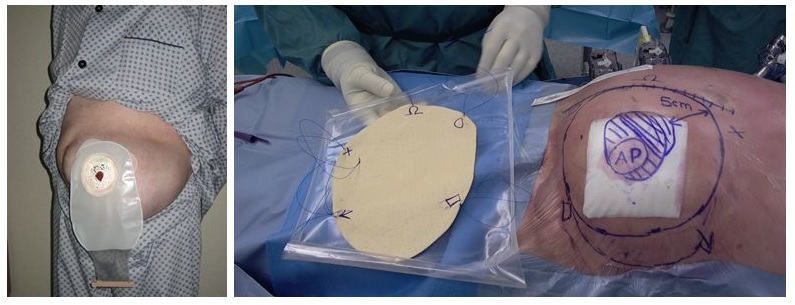Parastomal hernia
Symptoms and causes
Symptoms and causesWhat is it?
A parastomal hernia is an abdominal hernia adjacent to an artificial stoma.
A permanent artificial stoma sometimes needs to be placed in patients undergoing intestinal surgery. If a rectum tumour is close to the sphincter, sometimes the anus has to be removed and a colon stoma (colostomy) is placed.
In case of malignant tumours of the bladder, sometimes an artificial urinary outlet is created. This is done using a stoma made with small intestine (ileostomy). This requires an opening in the abdominal wall. And a hernia often forms next to the ostomy through which the intestines can protrude.

Diagnosis and treatment
Diagnosis and treatmentDoes every parastomal hernia require surgery?
A parastomal hernia is very common in patients who have a permanent stoma. According to some surgeons, almost all ostomy patients have a parastomal hernia to a greater or lesser degree. Research has shown that a parastomal hernia can be prevented in most patients by applying a prosthesis or a mesh around the stoma. However, colon surgery is considered a surgery where infection occurs very easily; therefore, most surgeons are afraid of placing a mesh out of fear of infection. Because a parastomal hernia often does not cause much discomfort, surgery is usually not performed and a watchful waiting approach is chosen.
The main reasons for a recovery operation of a parastomal hernia are:
- ostomy pain and parastomal hernia
- obstruction of the intestines protruding into the parastomal hernia
- difficulty applying the stomas and making them adhere properly
- difficulty rinsing the stoma
- aesthetic nuisance because the parastomal hernia can become very large
Because discomfort of a parastomal hernia often occurs at a later stage, patients with parastomal herniae who are undergoing surgery often have a large hernia.
Treatment
Read more about the different treatments: parastomal hernia repair.
Interesting link:
Treatment centres and specialisations
Treatment centres and specialisationsLatest publication date: 02/08/2024
Something wrong or unclear on this page? Report it.





